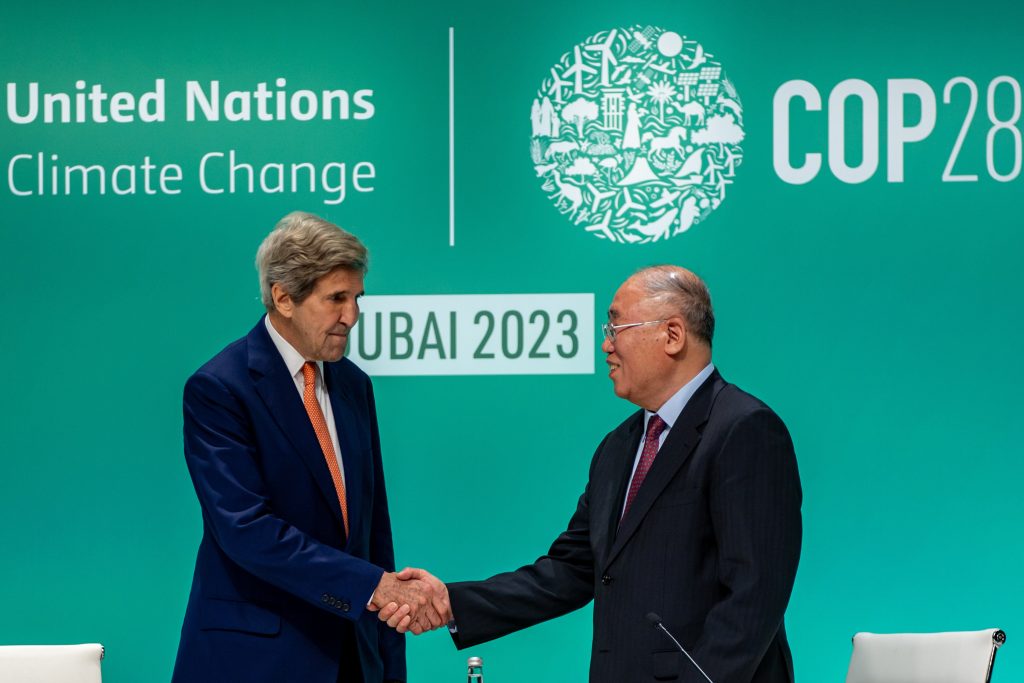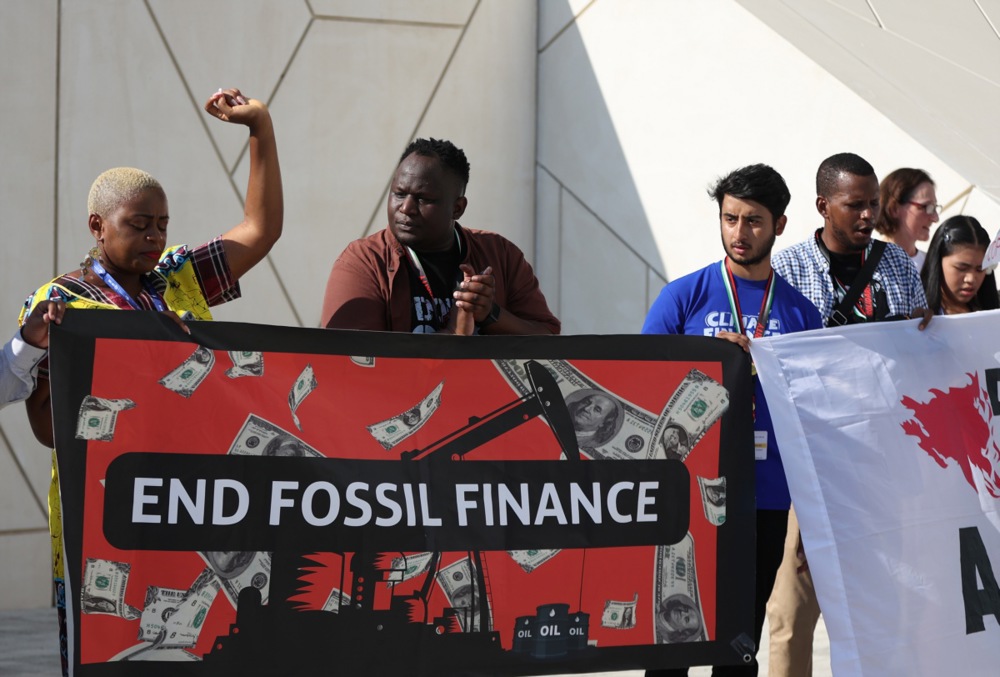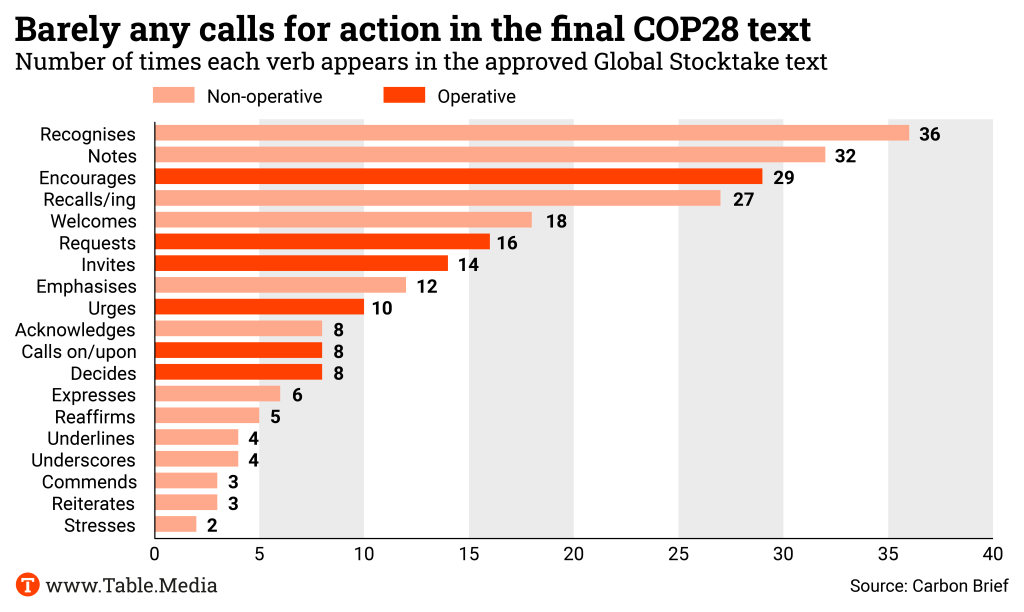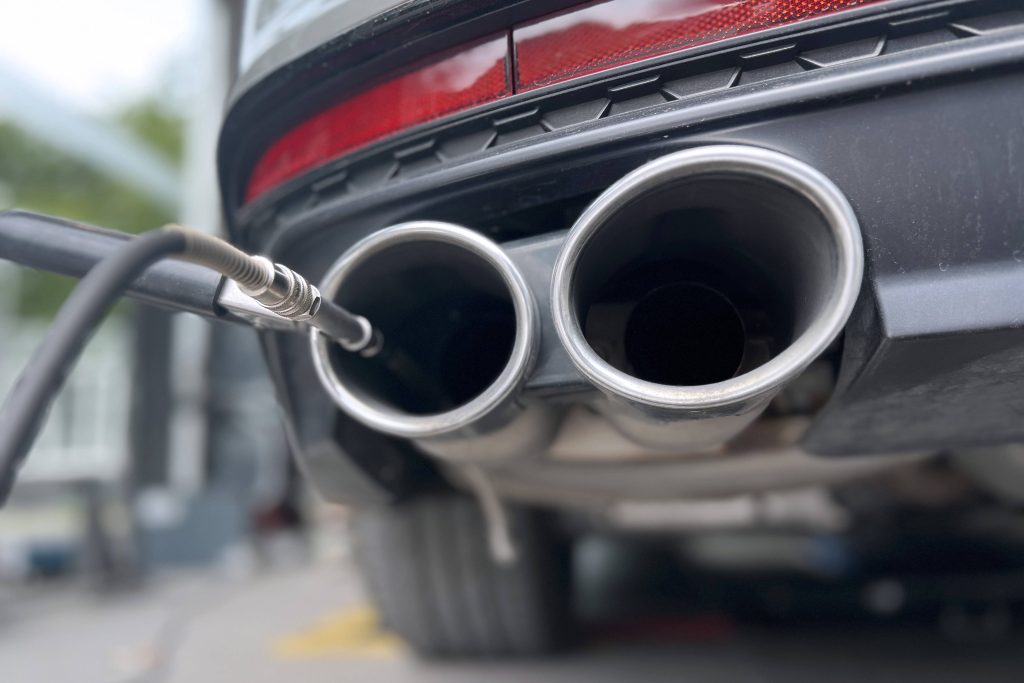After the gavel was struck at COP28 in Dubai, the year is slowly drawing to a close. A perfect opportunity to look back. What landmark decisions were made this year, which were missing, and what do this year’s developments mean for future climate policy? Bernhard Pötter and Alexandra Endres summarize 2023’s biggest milestones.
But looking back at the year always requires looking ahead to what’s to come. And there’s plenty in store for 2024: The question of who will pay for global climate financing will likely generate intense debate in many places. The IMF and World Bank will continue their reform efforts in this regard. The COP29 in Azerbaijan is likely to be a COP about money. And then there will also be a few landmark elections. 2024 will certainly not be boring!
If you still haven’t had enough of COP28, look at our Climate in Numbers. It reveals that the final text of the Global Stocktake contains many positive elements – but these are generally coupled with weak verbs, meaning that they hardly translate into a call for decisive action. Nevertheless, climate researcher Wolfgang Obergassel argues in his opinion piece that the UN climate conferences help advance global climate action. He believes they are worth the effort.
We hope you stay with us in the coming year, enjoy the holidays and have some relaxing days off. We will be back here on January 7.


The year regularly comes to an end for climate diplomacy with the most important and largest international event: the Conference of the Parties (COP) to the UN Framework Convention on Climate Change. What is decided – or not decided – at the climate summit has a significant impact on global and national climate policy. However, in addition to the many current resolutions adopted at the recent COP28 in Dubai, other developments and decisions have also shaped climate policy in 2023.
To mark the end of the year, here is a brief overview of the most important events:

The coming year will also again bring important developments in climate policy. Some of these are already apparent: global warming, for instance, will continue and its effects will make new headlines. Other trends will probably continue in the same direction as before – while decisions such as elections can lead to unexpected changes.
An overview of what could and will happen:
March 17, 2024
Elections Presidential election in Russia
April 19-21, 2024, Washington, USA
Conference World Bank and IMF Spring Meetings
The World Bank and the International Monetary Fund (IMF) are responsible for key climate finance issues. Their spring meeting is one of the most important events in this area alongside the annual meeting in the fall. Info
June 2, 2024
Elections Presidential election in Mexico
June 6-9, 2024
Elections European elections
The 2024 European elections will be the tenth direct elections to the European Parliament. It is expected to take place from June 6 to 9, 2024 in the member states of the European Union. 720 MEPs will be elected.
June 3-13, 2024, Bonn, Germany
Conference SBSTA60
The conference of the UNFCCC Subsidiary Body for Implementation serves primarily as a preparatory conference for COP29 in November. Info
June 17-19, 2024 (subject to change), Puglia, Italy
Summit meeting G7 Summit
The G7 summit will be held under the presidency of Italy. Info
July 12-14, Rio de Janeiro, Brazil
Summit meeting G20 Summit
The G20 summit under the presidency of Brazil will be held in Rio de Janeiro. The G20 comprises 19 countries and the EU. Info
Sept. 10-24, New York, USA
Annual General Meeting General Assembly of the United Nations Info
Oct. 21- Nov. 1, 2024 (subject to change), Colombia
Conference UN Biodiversity Conference
The biodiversity conference was originally due to take place in Turkey, but the country is not in a position to host it due to the earthquake. It is now being held in Colombia. Many issues at the intersection of climate and biodiversity will also be discussed. Info
Oct. 25-27, Washington, USA
Conference Annual Meetings of the World Bank and the IMF
The World Bank and the International Monetary Fund (IMF) play a major role in climate financing issues, as they provide the necessary financial architecture. Their annual meeting will take place in Washington in 2024. Info
Nov. 5, 2024
Elections Presidential elections USA
The candidates have not yet been officially announced. Primaries for the presidential election begin in mid-January. March 5 is the so-called “Super Tuesday.”
Nov. 11-24 2024 (subject to change), Baku, Azerbaijan
Conference COP29
It is now clear where the next UN Climate Change Conference will be held. However, the topics are still rather vague. What is certain is that climate financing will once again play a big role, as will presumably adaptation to the effects of climate change.

How clearly did COP28 herald the end of the fossil fuel age? COP resolutions are packed with semantic nuances. No wonder, as they are meant to advance international climate action while being accepted by all countries negotiating at the UN climate summits – including petrostates.
The Global Stocktake, the core document of this year’s COP, is no different. The text does provide a clear course: away from coal, oil and gas. However, the call to transition away from fossil fuels remains remarkably vague. This is revealed in an analysis of the text by the British climate news service Carbon Brief, which counted the verbs used in the Global Stocktake (GST). Our chart shows the result.
A glance at the verbs used in the final document illustrates that only very few of them clearly require countries to take action. More than 30 times each, the text merely recognizes things or “notes” them. It only “encourages” 29 times.
The Global Stocktake recalls, welcomes, emphasizes, acknowledges, recommends, repeats and underlines – sometimes even using synonyms, with subtle differences that are hard to make out. Even some of the calls to action remain remarkably vague: the text “requests” something 16 times, “invites” 14 times and calls for action 8 times. Very rarely does it dare to actually “decide” something (8 times). How much progress it brings will now depend on the goodwill of all involved. ae

The EU countries will only cut greenhouse gases by 51 percent by 2030 instead of the agreed 55 percent under their national climate targets. This is what the Commission writes in its assessment of the draft National Energy and Climate Plans (NECP), which was published on Monday. The renewable energy plans of the member states also fall short of the EU targets. Together, they will probably only achieve a maximum share of 39.3 percent of energy consumption. The EU target is 42.5 percent.
By mid-2024, all EU member states must revise their drafts and submit their final climate plans to the Commission. ber

Are the outcomes of the UN climate summit worth the effort? After COP28 in Dubai, this question is being raised once again. Two other questions can help answer it: What problem are international climate conferences meant to solve, what goal are they meant to achieve in the first place? And what can the summits contribute to this?
It is supposed to tackle the problems of progressing climate change, and the goal is nothing less than the total transformation of the global economy. Such transformation processes usually take decades. Naturally, a single UN conference is not enough to initiate them or even bring them to a successful conclusion.
Above all, however, such far-reaching transformations always produce winners and losers. In the case of international climate policy, for example, most documented fossil fuel reserves must remain underground. The IEA already pointed out in 2021 that if the world is to have any chance of staying within the 1.5-degree limit, no new oil, gas or coal mining projects must be approved. But, many countries and companies are heavily dependent on these resources.
Naturally, the losers do not simply accept these losses. They fight to maintain their prosperity and their market position. A prime example of this – albeit at a national level – was this year’s dispute over the German Buildings Energy Act. Its central question: How long can the oil and gas heating system providers continue with their business model?
International processes accelerate such conflicts. Important political debates are initiated by creating an annual political moment where climate action is at the heart of the agenda and political decision-makers are forced to adopt a position.
The Paris Agreement has permanently embedded this pacemaker function in the political processes of all signatory states by creating a five-year cycle in which the submission of Nationally Determined Contributions (NDCs), the Global Stocktake and new NDCs based on it follow each other.
The UN process creates additional pressure on countries with high emissions because poorer countries – those most vulnerable to climate change – also have a seat and a voice. It also provides information that would probably not be available without it. We know how significant the discrepancy is between ambition and actual action because countries have to regularly report internationally on their emissions and measures as part of the UN negotiations.
In addition, the decisions made at the conferences set the benchmark for what behavior by governments – or other actors – is deemed acceptable. In this way, they provide significant legitimacy for all actors aiming to progress national or international climate action.
For instance, the climate movement Fridays for Future bases its demands on the Paris Agreement. More and more court rulings do the same, such as the German Federal Constitutional Court’s ruling from 2021, in which it found the German Climate Change Act in its version at the time insufficient.
At COP28, it was finally possible for the first time to identify fossil fuels as the central cause of the climate problem and to call for a “transition away from them.” The conference has thus generated further leverage for future political and legal disputes.
Outside the official negotiations, the annual conference is also a key platform for networking climate policy stakeholders, sharing knowledge and announcing new pioneering initiatives.
Numbers also show how much the UN summits help advance climate action. When the Paris Agreement was adopted, the global average temperature was predicted to rise by 3.5 to 4 degrees by the end of the century. Today, only 2.5 to 3 degrees are expected – this is still far too high, and the progress cannot be attributed solely to the Paris Agreement. By the same token, it is hard to imagine that progress on this scale would have been achieved without international processes.
Future conferences could further break down the abstract problem of global climate change into practically manageable sub-problems. COP28 sends out a signal for the global energy transition. However, the equally crucial green transition in transport, heating, agriculture and industry has been barely discussed.
Climate summits should devote more attention to the green transformation of these sectors. And they should keep a closer eye on what individual countries have already done to restructure the transport, building heating, agricultural and industrial sectors, instead of focusing on the development of national emissions as has been the case so far. For example, relevant ministries could be asked to explain how they implement the goals of the Paris Agreement in their respective sectors as part of the international transparency mechanisms.
Wolfgang Obergassel is Co-Head of the Research Unit Global Climate Governance at the Wuppertal Institute. His work focuses on the development of the international climate regime and its mechanisms.
After the gavel was struck at COP28 in Dubai, the year is slowly drawing to a close. A perfect opportunity to look back. What landmark decisions were made this year, which were missing, and what do this year’s developments mean for future climate policy? Bernhard Pötter and Alexandra Endres summarize 2023’s biggest milestones.
But looking back at the year always requires looking ahead to what’s to come. And there’s plenty in store for 2024: The question of who will pay for global climate financing will likely generate intense debate in many places. The IMF and World Bank will continue their reform efforts in this regard. The COP29 in Azerbaijan is likely to be a COP about money. And then there will also be a few landmark elections. 2024 will certainly not be boring!
If you still haven’t had enough of COP28, look at our Climate in Numbers. It reveals that the final text of the Global Stocktake contains many positive elements – but these are generally coupled with weak verbs, meaning that they hardly translate into a call for decisive action. Nevertheless, climate researcher Wolfgang Obergassel argues in his opinion piece that the UN climate conferences help advance global climate action. He believes they are worth the effort.
We hope you stay with us in the coming year, enjoy the holidays and have some relaxing days off. We will be back here on January 7.


The year regularly comes to an end for climate diplomacy with the most important and largest international event: the Conference of the Parties (COP) to the UN Framework Convention on Climate Change. What is decided – or not decided – at the climate summit has a significant impact on global and national climate policy. However, in addition to the many current resolutions adopted at the recent COP28 in Dubai, other developments and decisions have also shaped climate policy in 2023.
To mark the end of the year, here is a brief overview of the most important events:

The coming year will also again bring important developments in climate policy. Some of these are already apparent: global warming, for instance, will continue and its effects will make new headlines. Other trends will probably continue in the same direction as before – while decisions such as elections can lead to unexpected changes.
An overview of what could and will happen:
March 17, 2024
Elections Presidential election in Russia
April 19-21, 2024, Washington, USA
Conference World Bank and IMF Spring Meetings
The World Bank and the International Monetary Fund (IMF) are responsible for key climate finance issues. Their spring meeting is one of the most important events in this area alongside the annual meeting in the fall. Info
June 2, 2024
Elections Presidential election in Mexico
June 6-9, 2024
Elections European elections
The 2024 European elections will be the tenth direct elections to the European Parliament. It is expected to take place from June 6 to 9, 2024 in the member states of the European Union. 720 MEPs will be elected.
June 3-13, 2024, Bonn, Germany
Conference SBSTA60
The conference of the UNFCCC Subsidiary Body for Implementation serves primarily as a preparatory conference for COP29 in November. Info
June 17-19, 2024 (subject to change), Puglia, Italy
Summit meeting G7 Summit
The G7 summit will be held under the presidency of Italy. Info
July 12-14, Rio de Janeiro, Brazil
Summit meeting G20 Summit
The G20 summit under the presidency of Brazil will be held in Rio de Janeiro. The G20 comprises 19 countries and the EU. Info
Sept. 10-24, New York, USA
Annual General Meeting General Assembly of the United Nations Info
Oct. 21- Nov. 1, 2024 (subject to change), Colombia
Conference UN Biodiversity Conference
The biodiversity conference was originally due to take place in Turkey, but the country is not in a position to host it due to the earthquake. It is now being held in Colombia. Many issues at the intersection of climate and biodiversity will also be discussed. Info
Oct. 25-27, Washington, USA
Conference Annual Meetings of the World Bank and the IMF
The World Bank and the International Monetary Fund (IMF) play a major role in climate financing issues, as they provide the necessary financial architecture. Their annual meeting will take place in Washington in 2024. Info
Nov. 5, 2024
Elections Presidential elections USA
The candidates have not yet been officially announced. Primaries for the presidential election begin in mid-January. March 5 is the so-called “Super Tuesday.”
Nov. 11-24 2024 (subject to change), Baku, Azerbaijan
Conference COP29
It is now clear where the next UN Climate Change Conference will be held. However, the topics are still rather vague. What is certain is that climate financing will once again play a big role, as will presumably adaptation to the effects of climate change.

How clearly did COP28 herald the end of the fossil fuel age? COP resolutions are packed with semantic nuances. No wonder, as they are meant to advance international climate action while being accepted by all countries negotiating at the UN climate summits – including petrostates.
The Global Stocktake, the core document of this year’s COP, is no different. The text does provide a clear course: away from coal, oil and gas. However, the call to transition away from fossil fuels remains remarkably vague. This is revealed in an analysis of the text by the British climate news service Carbon Brief, which counted the verbs used in the Global Stocktake (GST). Our chart shows the result.
A glance at the verbs used in the final document illustrates that only very few of them clearly require countries to take action. More than 30 times each, the text merely recognizes things or “notes” them. It only “encourages” 29 times.
The Global Stocktake recalls, welcomes, emphasizes, acknowledges, recommends, repeats and underlines – sometimes even using synonyms, with subtle differences that are hard to make out. Even some of the calls to action remain remarkably vague: the text “requests” something 16 times, “invites” 14 times and calls for action 8 times. Very rarely does it dare to actually “decide” something (8 times). How much progress it brings will now depend on the goodwill of all involved. ae

The EU countries will only cut greenhouse gases by 51 percent by 2030 instead of the agreed 55 percent under their national climate targets. This is what the Commission writes in its assessment of the draft National Energy and Climate Plans (NECP), which was published on Monday. The renewable energy plans of the member states also fall short of the EU targets. Together, they will probably only achieve a maximum share of 39.3 percent of energy consumption. The EU target is 42.5 percent.
By mid-2024, all EU member states must revise their drafts and submit their final climate plans to the Commission. ber

Are the outcomes of the UN climate summit worth the effort? After COP28 in Dubai, this question is being raised once again. Two other questions can help answer it: What problem are international climate conferences meant to solve, what goal are they meant to achieve in the first place? And what can the summits contribute to this?
It is supposed to tackle the problems of progressing climate change, and the goal is nothing less than the total transformation of the global economy. Such transformation processes usually take decades. Naturally, a single UN conference is not enough to initiate them or even bring them to a successful conclusion.
Above all, however, such far-reaching transformations always produce winners and losers. In the case of international climate policy, for example, most documented fossil fuel reserves must remain underground. The IEA already pointed out in 2021 that if the world is to have any chance of staying within the 1.5-degree limit, no new oil, gas or coal mining projects must be approved. But, many countries and companies are heavily dependent on these resources.
Naturally, the losers do not simply accept these losses. They fight to maintain their prosperity and their market position. A prime example of this – albeit at a national level – was this year’s dispute over the German Buildings Energy Act. Its central question: How long can the oil and gas heating system providers continue with their business model?
International processes accelerate such conflicts. Important political debates are initiated by creating an annual political moment where climate action is at the heart of the agenda and political decision-makers are forced to adopt a position.
The Paris Agreement has permanently embedded this pacemaker function in the political processes of all signatory states by creating a five-year cycle in which the submission of Nationally Determined Contributions (NDCs), the Global Stocktake and new NDCs based on it follow each other.
The UN process creates additional pressure on countries with high emissions because poorer countries – those most vulnerable to climate change – also have a seat and a voice. It also provides information that would probably not be available without it. We know how significant the discrepancy is between ambition and actual action because countries have to regularly report internationally on their emissions and measures as part of the UN negotiations.
In addition, the decisions made at the conferences set the benchmark for what behavior by governments – or other actors – is deemed acceptable. In this way, they provide significant legitimacy for all actors aiming to progress national or international climate action.
For instance, the climate movement Fridays for Future bases its demands on the Paris Agreement. More and more court rulings do the same, such as the German Federal Constitutional Court’s ruling from 2021, in which it found the German Climate Change Act in its version at the time insufficient.
At COP28, it was finally possible for the first time to identify fossil fuels as the central cause of the climate problem and to call for a “transition away from them.” The conference has thus generated further leverage for future political and legal disputes.
Outside the official negotiations, the annual conference is also a key platform for networking climate policy stakeholders, sharing knowledge and announcing new pioneering initiatives.
Numbers also show how much the UN summits help advance climate action. When the Paris Agreement was adopted, the global average temperature was predicted to rise by 3.5 to 4 degrees by the end of the century. Today, only 2.5 to 3 degrees are expected – this is still far too high, and the progress cannot be attributed solely to the Paris Agreement. By the same token, it is hard to imagine that progress on this scale would have been achieved without international processes.
Future conferences could further break down the abstract problem of global climate change into practically manageable sub-problems. COP28 sends out a signal for the global energy transition. However, the equally crucial green transition in transport, heating, agriculture and industry has been barely discussed.
Climate summits should devote more attention to the green transformation of these sectors. And they should keep a closer eye on what individual countries have already done to restructure the transport, building heating, agricultural and industrial sectors, instead of focusing on the development of national emissions as has been the case so far. For example, relevant ministries could be asked to explain how they implement the goals of the Paris Agreement in their respective sectors as part of the international transparency mechanisms.
Wolfgang Obergassel is Co-Head of the Research Unit Global Climate Governance at the Wuppertal Institute. His work focuses on the development of the international climate regime and its mechanisms.
